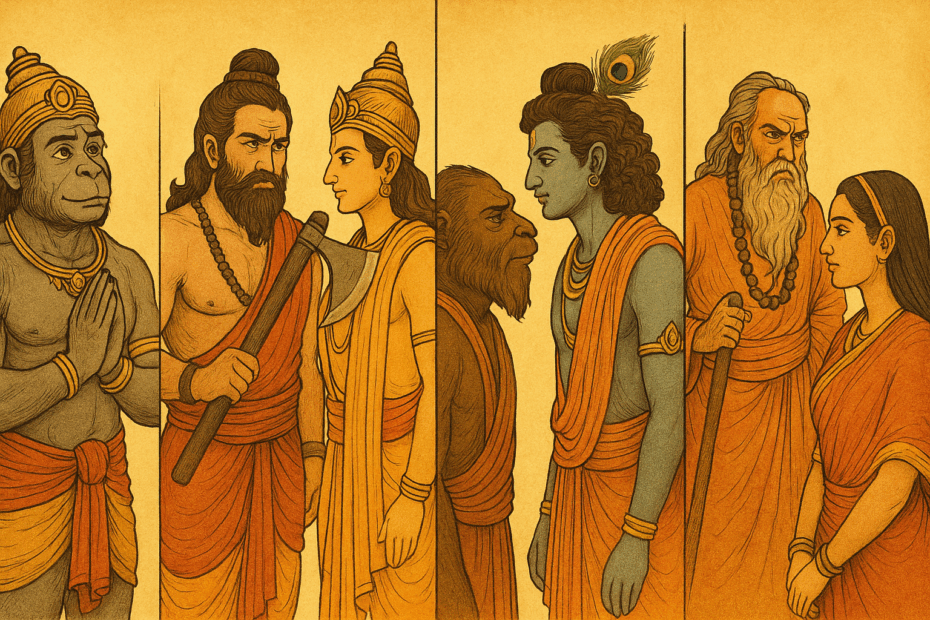When we think of the Ramayana and the Mahabharata, we imagine two vastly different worlds—distinct time periods, divine incarnations, and moral journeys. The Ramayana is from Treta Yuga, focused on Lord Rama and his path of righteousness. The Mahabharata is from Dwapara Yuga, revolving around Lord Krishna and the Kurukshetra war.
At first glance, they seem unrelated.
But what if we told you that certain divine beings lived through both eras?
Some characters, due to their divine status or immortality (chiranjeevi), appear in both the Ramayana and the Mahabharata, playing unique roles in each. Let’s explore who these timeless beings are and how they link our two greatest epics.
1. Lord Hanuman – The Immortal Devotee
In the Ramayana:
Hanuman is one of the most central and revered characters of the Ramayana. As a vanara (forest being), a mighty warrior, and a devoted disciple of Lord Rama, his contributions—from flying to Lanka, setting it ablaze, to carrying the Sanjeevani mountain—are legendary.
In the Mahabharata:
Most people don’t realize Hanuman appears in the Mahabharata too. During the Pandavas’ exile, Bhima encounters a frail monkey lying in his path. When he tries to move its tail and fails, the monkey reveals himself as none other than Hanuman. The two embrace, as both are sons of Vayu (the Wind God), making them spiritual brothers.
Later, Hanuman resides on Arjuna’s chariot flag (the “Kapidhwaja”) during the Kurukshetra war, protecting it with his divine presence.
Lesson:
Hanuman’s presence across yugas reflects that devotion, humility, and strength are eternal virtues. His immortality reminds us that true bhakti (devotion) transcends time.
2. Parashurama – The Sage Warrior Across Ages
In the Ramayana:
Parashurama, the fierce Brahmin warrior and sixth avatar of Vishnu, appears after Lord Rama breaks the Shiva Dhanush (bow) at Sita’s swayamvar. Enraged at the breaking of the divine bow, Parashurama confronts Rama, but upon realizing his identity as the next Vishnu avatar, he bows and retreats.
In the Mahabharata:
Parashurama plays a much deeper role in this epic:
-
He mentors Bhishma in warfare and is later challenged by him in a mighty battle.
-
He teaches Karna archery, although he curses Karna unknowingly when he discovers Karna lied about his true identity as a non-Brahmin.
Parashurama is one of the Saptachiranjeevis, destined to live till the end of the age and train the final avatar, Kalki.
Lesson:
Parashurama is the bridge between divine authority and martial power, reminding us that truth, discipline, and dharma demand constant vigilance—even across lifetimes.
3. Jambavan – The Eternal Bear King
In the Ramayana:
Jambavan was the wise and powerful bear warrior who served Lord Rama during the battle against Ravana. He played a crucial role in:
-
Reminding Hanuman of his true strength and ability to fly across the ocean,
-
Participating in Lanka’s war, and
-
Helping build the bridge to Lanka (Ram Setu).
In the Mahabharata:
Jambavan reappears centuries later. When Krishna seeks the Syamantaka gem, he enters into battle with Jambavan, unaware of his identity. They fight fiercely for 28 days. Once Jambavan realizes Krishna is an incarnation of Rama, he stops the fight and offers not just the gem but also his daughter Jambavati’s hand in marriage.
Lesson:
Jambavan’s tale shows that wisdom and devotion are ageless, and true recognition of God transcends form and name.
4. Mayasura – The Architect of Demons and Kings
In the Ramayana:
Mayasura is the father of Mandodari, Ravana’s wife. A brilliant architect, demon, and astrologer, he was known for his deep knowledge of Vastu (architecture) and Jyotish (astrology). Though associated with the demons, he wasn’t evil himself.
In the Mahabharata:
After the burning of Khandava forest, Mayasura is the lone survivor, spared by Arjuna and Krishna. In gratitude, he builds the famous Maya Sabha (Maya’s Palace) for Yudhishthira—an enchanting illusion-filled hall that becomes the site of Duryodhana’s humiliation, triggering the chain of events that lead to the great war.
Lesson:
Mayasura represents the truth that art, craft, and knowledge can serve both good and evil—it depends on the intention behind their use.
5. Sage Durvasa – The Fiery Seer with a Deeper Purpose
In the Ramayana:
Durvasa, famous for his temper and mystical powers, appears as a seer in King Dasharatha’s court. He is said to have made predictions about the future of the Ikshvaku dynasty and Ram’s path.
In the Mahabharata:
Durvasa’s presence is even more striking here. During the Pandavas’ exile, he visits Draupadi’s hut with 10,000 disciples, demanding food. Draupadi, terrified due to lack of provisions, prays to Krishna. Krishna arrives, eats a single grain stuck in her vessel, and Durvasa and his disciples feel fully satisfied.
Lesson:
Durvasa’s character teaches us that divine tests often come disguised in hardship. His presence in both epics shows that seers often play the role of testing dharma under pressure.
Conclusion: Are the Epics Connected?
Though the Ramayana and Mahabharata are set in different ages, they are spiritually connected by these recurring, divine characters. They reveal a continuous thread of dharma, karma, and divine will that flows across yugas.
These characters are not mere bridges between two epics—they are the living pillars of Sanatan Dharma, reminding us that while times change, the essence of righteousness, devotion, and spiritual discipline remains the same.
🔖 Did You Know?
-
Hanuman is believed to be still alive in the Himalayas, meditating on Rama.
-
Parashurama will reappear to teach Lord Kalki the art of war in the next yuga.
-
The Maya Sabha, crafted by Mayasura, remains a symbol of wonder in ancient Indian architecture.
-
Jambavan lived long enough to witness the third avatar of Vishnu (Krishna), after having served the seventh (Rama).
